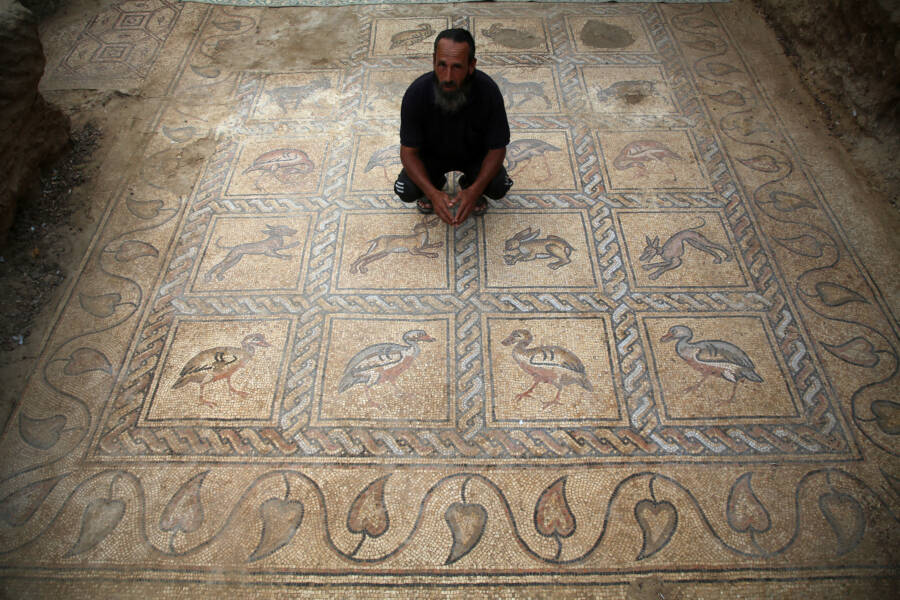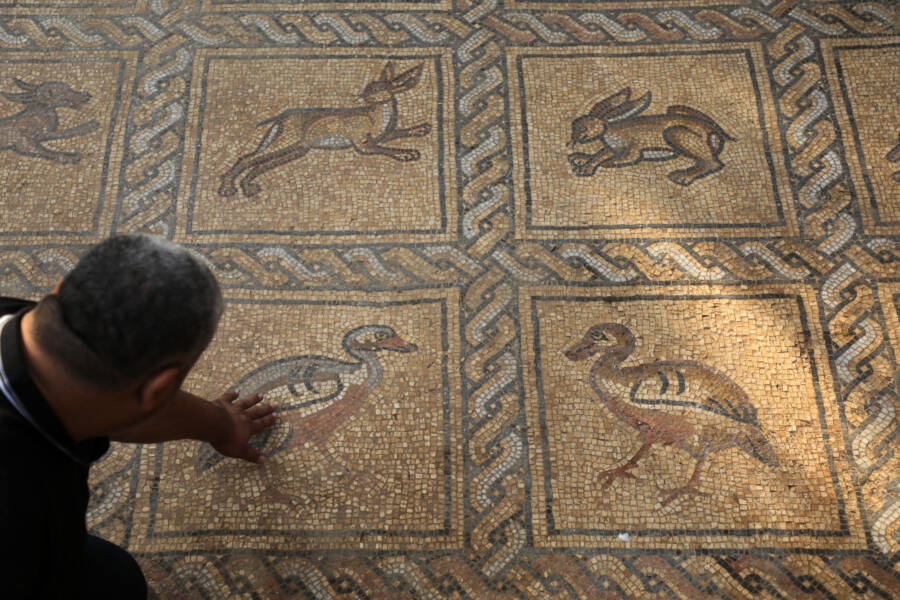The mosaic dates back to sometime between the fifth and seventh centuries, a time when the Gaza Strip was a bustling center of commerce.
While working in his olive orchard in Gaza, half a mile from the Israeli border, a farmer discovered an ornate mosaic decorated with colorful birds and other animals buried beneath the dirt.

Majdi Fathi/NurPhoto via Getty ImagesPalestinian farmer Salman al-Nabahin uncovered the mosaic floor while working in his olive orchard.
Salman al-Nabahin made the discovery after planting new trees in his orchard in the Bureij refugee camp, The Guardian reported. When some of the trees failed to properly take root, Nabahin and his son dug into the earth to find out why.
When their ax struck something hard and unfamiliar, they brushed aside the dirt and took to the internet to find out what they had hit.
“We learned it was mosaic belonging to the Byzantine era,” Nabahin said. “I see it as a treasure, dearer than a treasure. It isn’t personal, it belongs to every Palestinian.”
The Palestinian Ministry of Tourism and Antiquities said that in addition to the birds and animals, the mosaic also depicts various social features of the Byzantine era. So far, at least 17 different images have been unearthed.
“The archaeological discovery is still in its early stages and we await to know more of the secrets and civilization values,” the ministry said in a statement. “National research teams are working in partnership with international experts and scientists from the French Biblical and Archaeological School of Jerusalem.”

Majdi Fathi/NurPhoto via Getty ImagesThe detailed mosaic was found just half a mile from the Israeli border.
Additionally, The Jerusalem Post reported, pottery and glass bottles from the era were found at the site as well.
“This provides us with historical information and details about the ancient civilizations and anthropology in Gaza, the historical and economic relations with the ancient regional environment, and the status of Palestine across the world,” the ministry said.
An archaeologist from the French Biblical and Archaeological School of Jerusalem, René Elter, called the tiles “the most beautiful mosaic floors discovered in Gaza, both in terms of the quality of the graphic representation and the complexity of the geometry.”
Elter dated the mosaic to approximately somewhere between the fifth and seventh centuries, but he said that further excavation would be required to provide more accurate information as to the mosaic’s exact time period and purpose. Some archaeologists have posited that the piece may have been part of the floor of a church or even a private villa.

Majdi Fathi/NurPhoto via Getty ImagesSalman al-Nabahin and his son assisting with the cleaning of the mosaic floor.
The mosaic marks the latest in a recent trend of archaeological discoveries in the Gaza region, but unfortunately, a lack of funding has made it necessary for international groups to assist with the excavation and preservation of these magnificent finds.
Per Al Jazeera, the Gaza Strip was once a prominent trade route between Egypt and the Levant in ancient times. As a result, many relics have been found in the region, some dating back as far as the Bronze Age, as well as to the Roman and Ottoman eras.
It is understandable, then, why Nabahin expressed so much pride over the mosaic he found. It is a tangible piece of his own Palestinian history.
After learning about this remarkable find, discover the story of the Greek farmer who uncovered a Minoan tomb beneath his olive grove. Then, read about a similar Roman mosaic that was unearthed in London.





